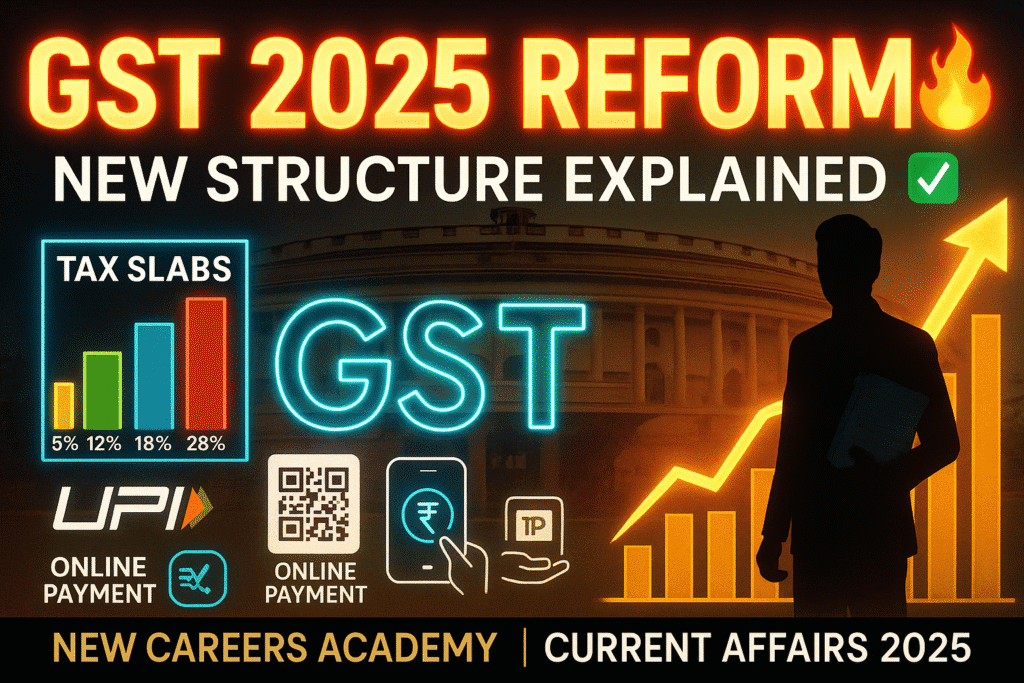Goods and Services Tax (GST) 2025 Reforms
Goods and Services Tax (GST): India’s Game-Changing Tax Reform
The Goods and Services Tax (GST) is India’s most significant indirect tax reform, designed to simplify taxation by replacing multiple state and central taxes with a unified system. Introduced on July 1, 2017, GST has created a seamless market, reduced cascading taxes, and improved compliance. With the latest GST 2025 reforms, the structure is further streamlined into a two-tier tax system, impacting businesses, consumers, and the overall economy.
What is Goods and Services Tax (GST) in India?
The Goods and Services Tax (GST) is a destination-based indirect tax on the supply of goods and services across India.
GST is levied at the point of consumption, not production.
It replaced taxes like Excise Duty, Service Tax, VAT, CST, and Entry Tax.
Businesses can claim input tax credit, ensuring only value addition is taxed.
GST embodies the principle of “One Nation, One Tax”.
This makes GST one of the most transformative reforms in the Indian economy.

History of GST in India 2017
2000: The Empowered Committee of State Finance Ministers first discussed GST.
2016: The 101st Constitutional Amendment Act paved the way.
1st July 2017: GST was officially launched by Prime Minister Narendra Modi, marking a new chapter in India’s indirect taxation system.
Types of Taxes Replaced by GST
GST subsumed a variety of indirect taxes:
Central Excise Duty
Service Tax
Additional Excise Duties
Countervailing Duty (CVD) and Special Additional Duty (SAD)
Value Added Tax (VAT) and Sales Tax
Octroi and Entry Tax
Luxury Tax
Entertainment Tax (except local body levies)
Purchase Tax
This eliminated tax-on-tax (cascading effect) and made compliance easier.
GST Structure in India
India follows a dual GST model where both Centre and States levy taxes:
Central GST (CGST): For intra-state supplies collected by the Centre.
State GST (SGST)/UTGST: For intra-state supplies collected by States/UTs.
Integrated GST (IGST): For inter-state trade and imports.
Compensation Cess: For luxury & sin goods, ensuring states don’t lose revenue.
Difference Between CGST, SGST and IGST
| Tax Type | Levied By | Applicable On | Example |
|---|---|---|---|
| CGST | Central Govt. | Intra-state supply | Supply within Delhi |
| SGST/UTGST | State/UT Govt. | Intra-state supply | Supply within Maharashtra |
| IGST | Central Govt. | Inter-state supply/imports | Supply from Maharashtra to Karnataka |
Who Heads the GST Council in India?
The GST Council is the apex body that makes decisions on tax rates, reforms, and exemptions.
Chairperson: Union Finance Minister (Currently Nirmala Sitharaman)
Members: Finance Ministers of all states and UTs
The GST Council ensures uniformity across the country and plays a key role in reforms such as the GST 2025 changes.
GST Drawing Rights and Input Tax Credit
Businesses can claim input tax credit (ITC) for taxes paid on inputs, reducing the tax burden.
Example:
Manufacturer pays GST on raw materials → Claims credit.
Retailer pays GST on goods purchased → Claims credit.
Final consumer → Cannot claim ITC (tax burden rests with them).
This system ensures taxation only on value addition.
GST 2025 Latest Reforms Explained
The 56th GST Council meeting (September 2025) introduced major reforms:
New GST Two-Tier Tax System
5% slab → For essentials and mass consumption goods.
18% slab → For most goods and services.
40% slab → For luxury and sin goods like tobacco, pan masala, aerated drinks, luxury cars, yachts, private aircraft.
Key Highlights
12% and 28% slabs removed → Merged into simpler categories.
Sectoral relief → Lower GST on medical products, education, construction materials, household essentials.
Enhanced digitalization → Faster filing, refunds, and compliance.
Compensation cess continuity → On specific goods until obligations are met.
Effective date → 22nd September 2025.
This reform is expected to boost businesses and ease compliance, making GST more efficient.
GST MCQs for UPSC & Exams
| Question | Option A | Option B | Option C | Option D | Answer |
|---|---|---|---|---|---|
| When was GST implemented in India? | 1st May 2016 | 1st July 2017 | 1st April 2015 | 1st Jan 2018 | B |
| Which tax was replaced by GST? | Income Tax | Excise Duty | Customs Duty | Import Duty | B |
| Who chairs the GST Council? | PM | RBI Governor | Finance Minister | Chief Justice | C |
| What are the new GST rates (2025)? | Only 18% | 5% & 18% | 5%, 12%, 18%, 28% | Only 28% | B |
| GST is a tax on | Production | Consumption | Export | Income | B |
| Which amendment introduced GST? | 100th | 101st | 102nd | 103rd | B |
| Who can claim GST input tax credit? | Final Consumer | Exporter only | Businesses | None | C |
| From when are GST 2025 reforms effective? | 1st July 2025 | 22nd Sept 2025 | 1st Jan 2026 | 15th Aug 2025 | B |
| GST is a | Direct Tax | Indirect Tax | Wealth Tax | Capital Gains Tax | B |
| Which is NOT covered under GST? | Alcohol (for human consumption) | VAT | Service Tax | Excise Duty | A |
Advantages of GST in Indian Economy
Eliminates cascading tax effect.
Creates one unified market.
Boosts ease of doing business.
Increases tax compliance & transparency.
Promotes digital filing & automation.
For small businesses, GST reforms reduce compliance costs and open opportunities for interstate trade.
Why Choose New Careers Academy (NCA) for GST Current Affairs?
Trusted sources – The Hindu, PIB, and official notifications.
Exam-focused coverage – Prelims, Mains, and Interview preparation.
Regular updates – Daily & weekly modules.
MCQs & practice – Strengthens conceptual clarity.
Expert guidance – Faculty-led discussions & doubt-solving.
Choosing NCA ensures UPSC & other competitive exam aspirants stay ahead with the latest reforms like GST 2025.





